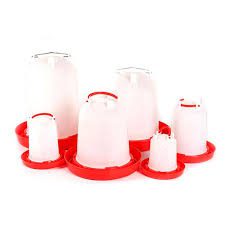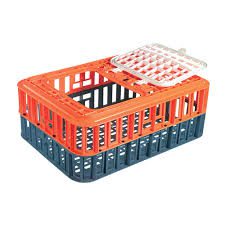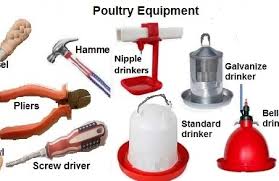Poultry equipment is made up of instruments or tools used for a particular job or activity in poultry production management. Poultry houses can not function satisfactorily unless they are properly equipped and supplied with appliances. These are the basic requirements for the successful management of fowls.
Poultry equipment can be broadly grouped into those for general applications and those for specific applications. Those for general applications are used at all post-natal stages of growth; these consist mainly of feeders, drinkers, and crates. Those for specific stages of growth include brooders for chicks-brooding and nests for layers.
Different Types of Poultry Equipment
1. Poultry Feeders
Feeders are appliances used to supply feed to the birds. The construction of feeders should be such to avoid waste, prevent fouling of feed with droppings and litter, facilitate cleaning or washing, and should be constructed from durable materials.
If timber is used for construction, preservatives like solarium should be used to prevent fungal or insect damage.
Feeders are mostly troughs or hoppers. The trough feeder comes in a variety of sizes and designs. The length can be about 0.6m to 1.6m
The base width of a sloping-sided trough is about 5-8cm when the trough is for 8-week-old birds and 20-25cm for an adult.
The feeders could have legs that lift them above the litter.
The top of each of the long sides is curved in to form a “lip” as a means of limiting feed waste.
The height of the feeder should always be set level with the back of the bird. Some of them have been covered at the top end.
Read Also: 4 Ways to add Value to your Poultry Eggs for more Profit
2. Poultry Conical Drinkers

The most common form of a drinker is the water fountain, which may be made of galvanized iron, aluminum, plastic, or clay. They are usually conical or partly cylindrical. They vary in capacity from 2 to 6 or 8 liters The shape should facilitate quick and thorough washing.
Some drinkers are trough-shaped. They are made of galvanized angle iron. Bars spaced at 7.5cm prevent fouling of the water. The trough may be filled manually or by an automatic device based on a spring-loaded ball valve attached to the supply pipe.
The base of the drinker should have a groove that controls the water flow to the surrounding.
3. Perch
This equipment is necessary for deep litter houses. It provides resting or roosting places.
It is made of metal, wood, or plastic. It is of moderate height, to minimize egg breakages.
4. Chicken Nests
This equipment is peculiar to the management of layers and breeders. Chicken nests are compartments in which eggs are laid. The compartments may be such that can be used by one or more birds at a time.
Some nests are single or open-fronted nests where dimensions are 25-30cm wide, 30-35cm high and 30 -36 cm deep.
There is a 1.5-10cm litter-retaining board across the front. There is also an alighting perch 10cm from where the birds can alight before entering the nest.
Ideally, there should be a means for closing the nests in the evening so that birds don’t roost in dirty eggs.
Two types of nest boxes could be used; they are individual nest boxes and colony nest boxes.
Nests could be arranged in 2-3 tiers, each having four to six nests. The lowest tier could be about 45cm off the floor.
Read Also: How to Make Money as a Poultry Farmer
5. Chicken Crates

These are perforated or well-ventilated boxes for the transfer of adult fowls and sometimes growers.
The crates could be made of light wood or plastic. framework on iron. They could be used to convey 15-25 birds at a time depending on their age and size. Corners of the crate should not be sharp, to prevent pilling and suffocation.
6. Poultry Brooders
Brooders provide heat for young birds for the first few weeks of life during which they are unable to regulate their own body temperature.
Brooder guards restrict the young birds to within the vicinity of heat and feed supply.
Brooder guards can be made from flexible materials such as ceiling boards cardboard or wire netting.
Brooder types include charcoal or wood stoves, kerosene lamp or stoves, electric heaters or bulbs, and brooder hens.
6. Other Tools
It is good to be well equipped with tools because it encourages a “do it yourself” attitude, which encourages innovation and self-relevance. Example: pliers, shovels, wheelbarrow, cutlasses, holes, rakes, hammer, saw, screwdrivers, scoops, etc.
Read Also: How Supporting Farmers Can Benefit Our Communities

